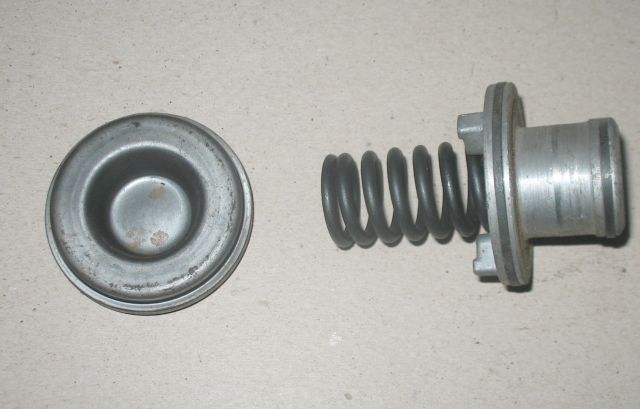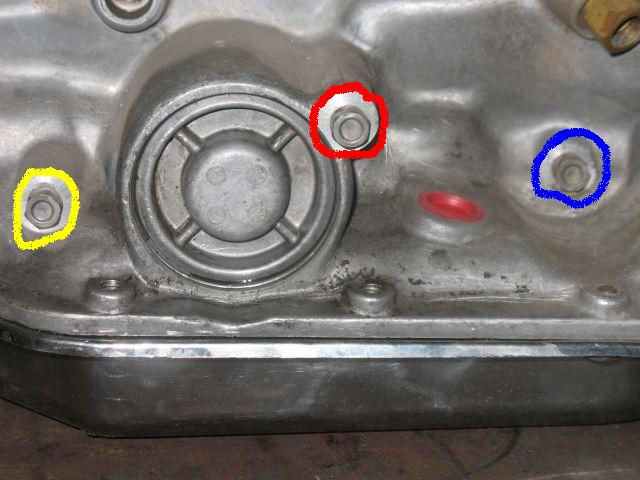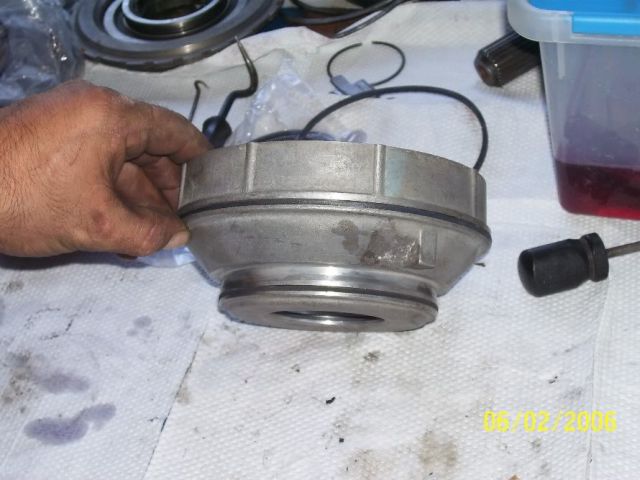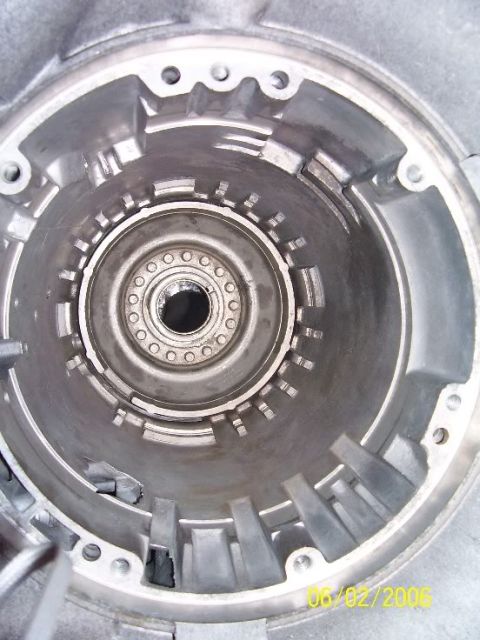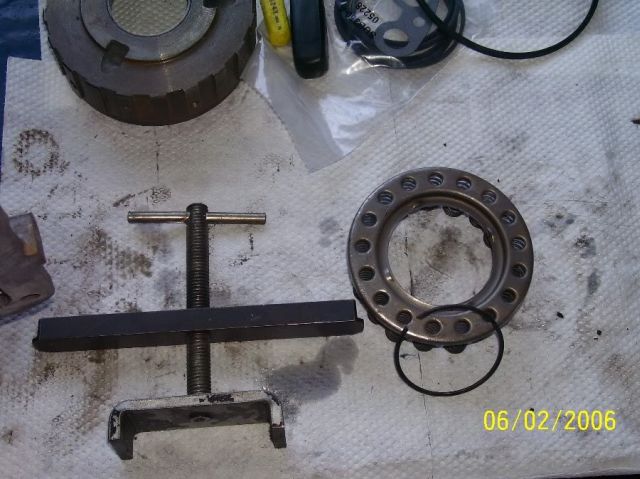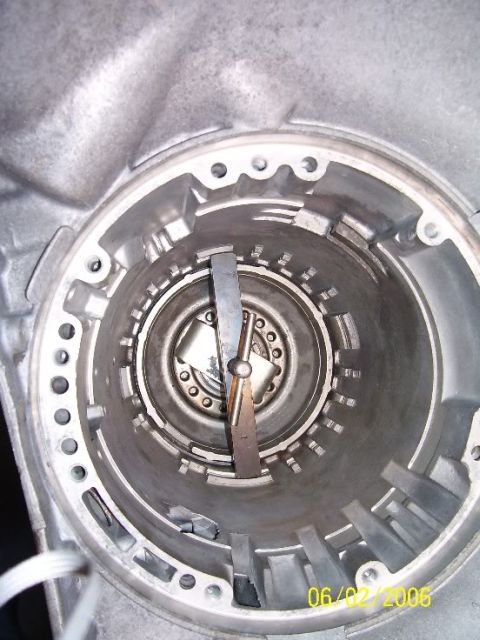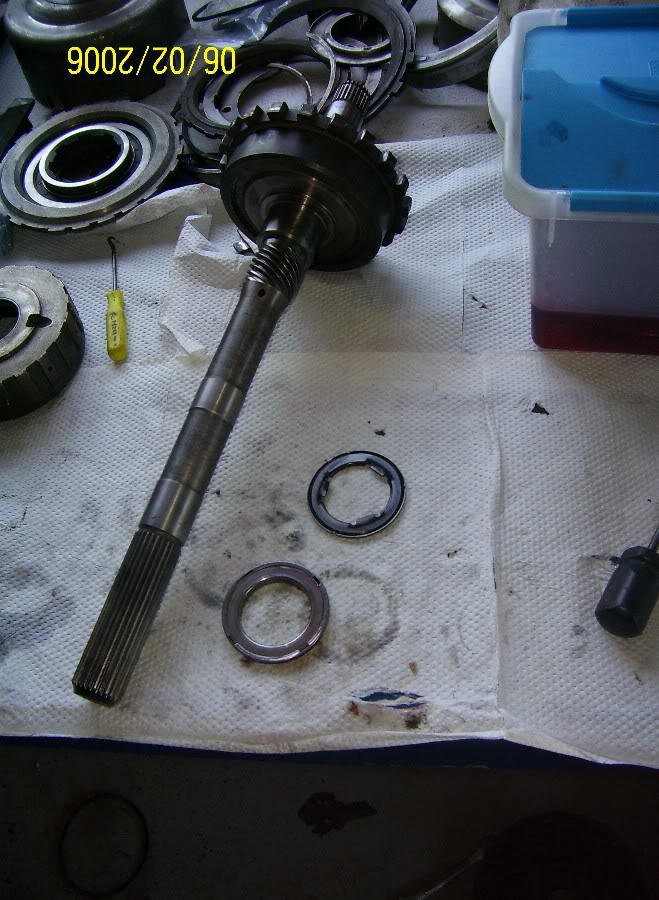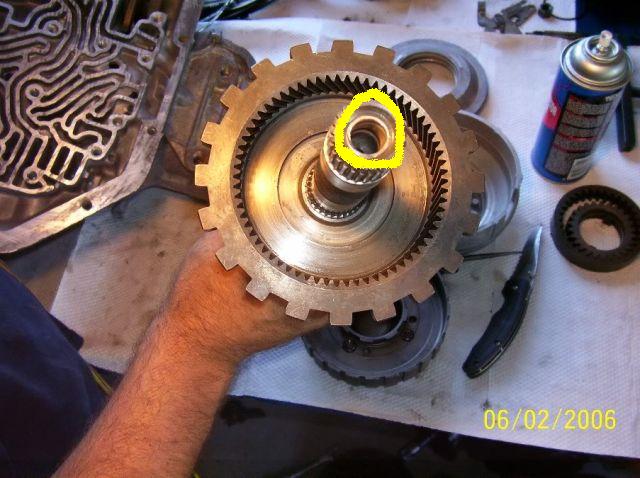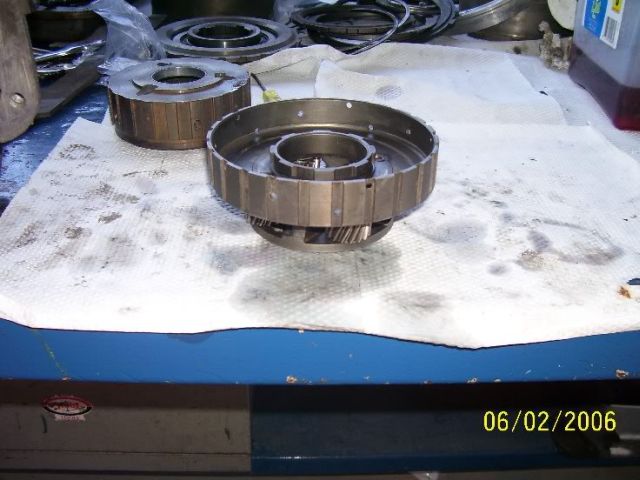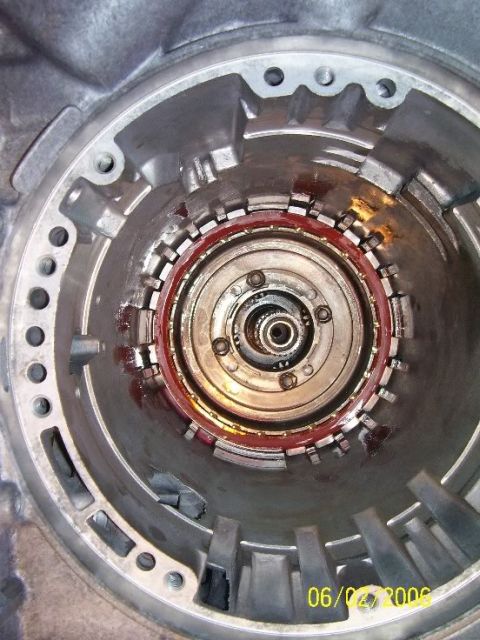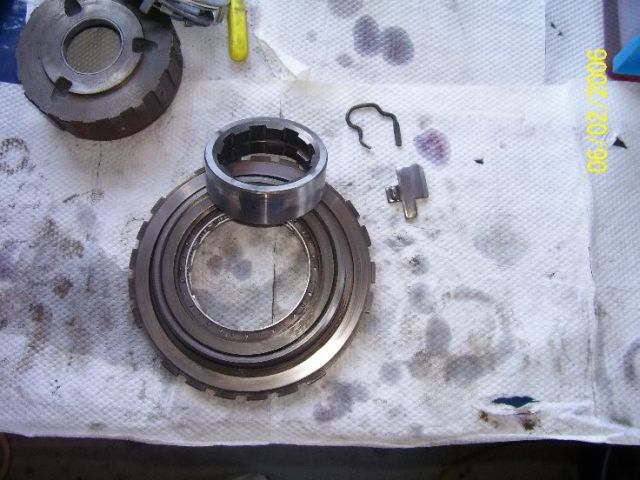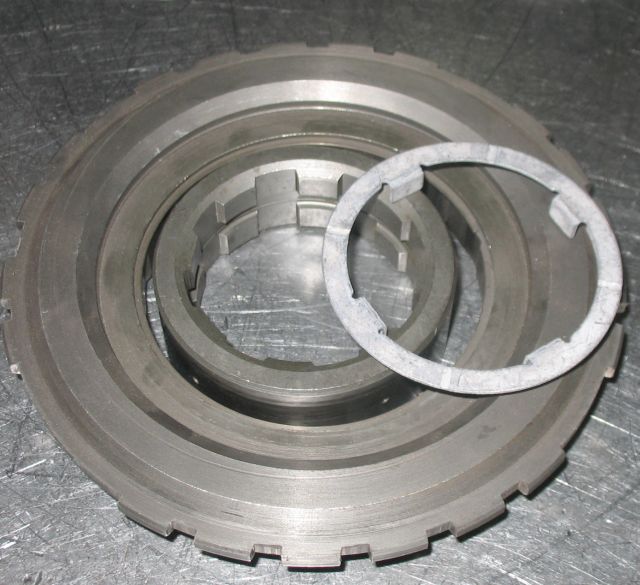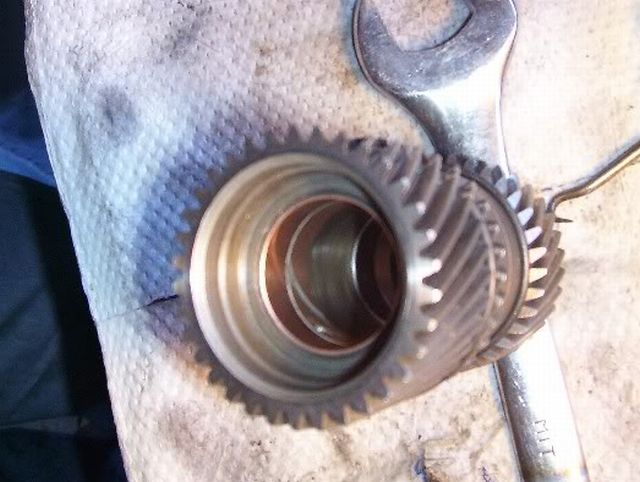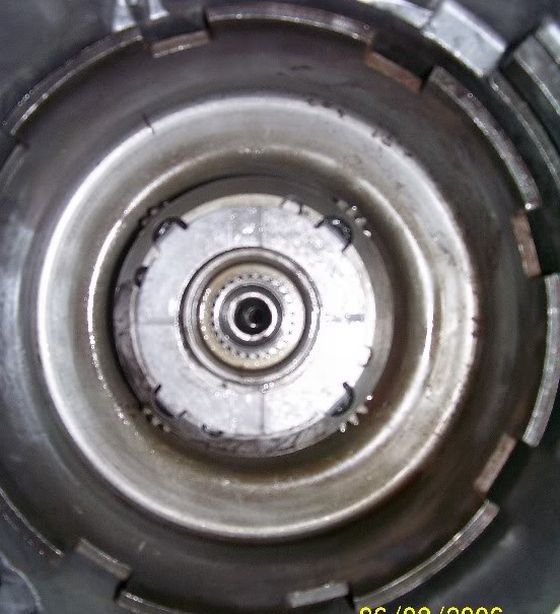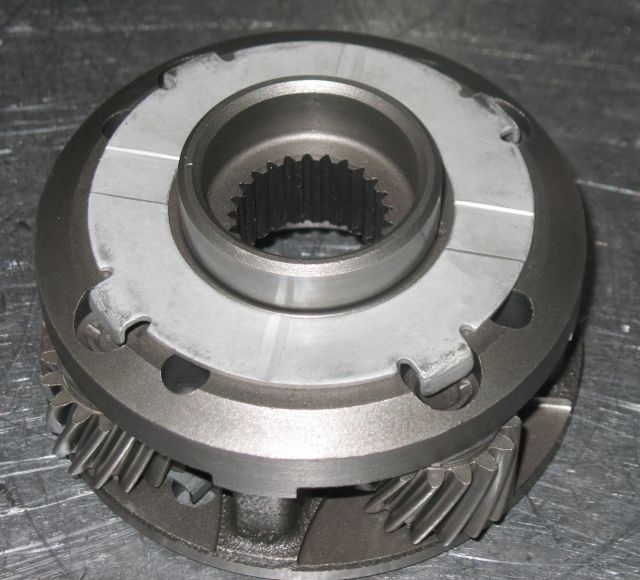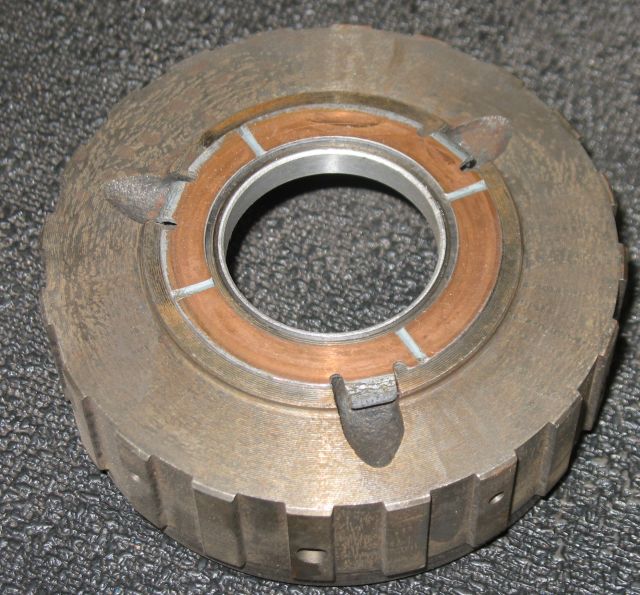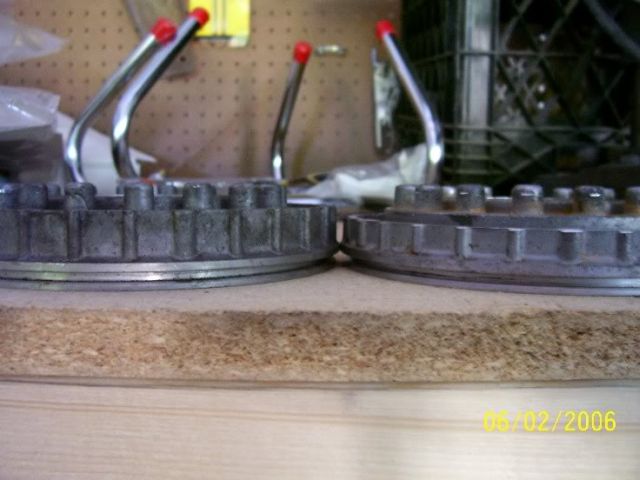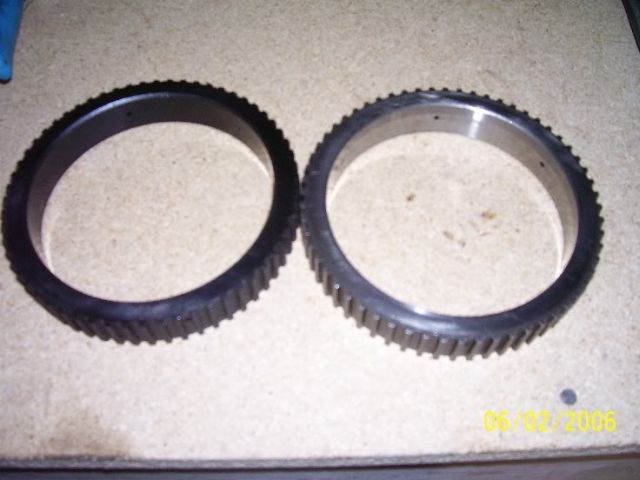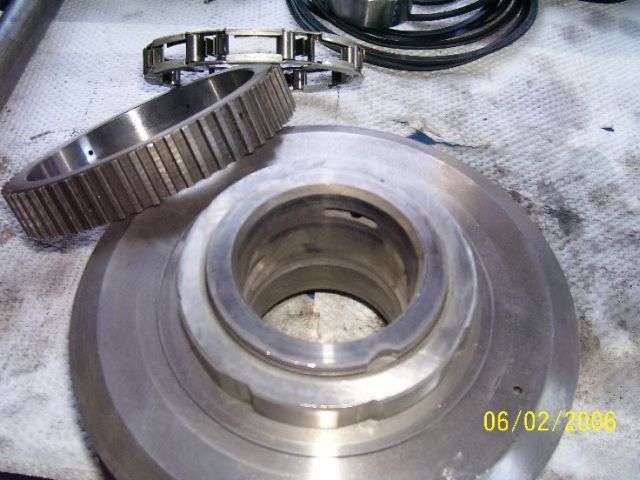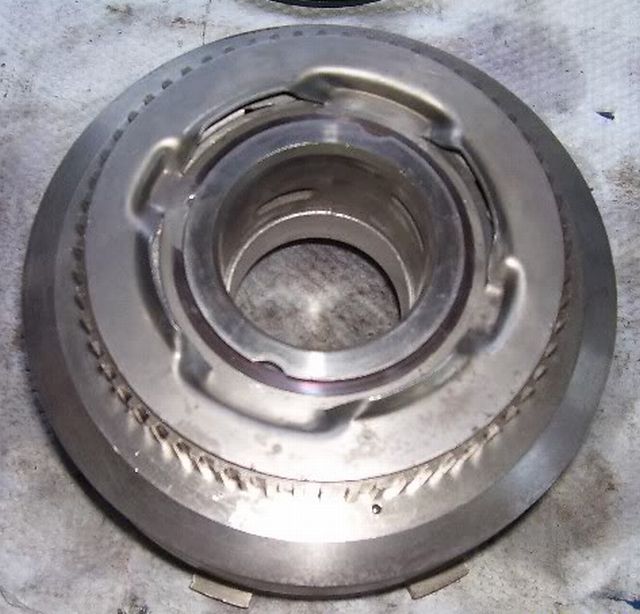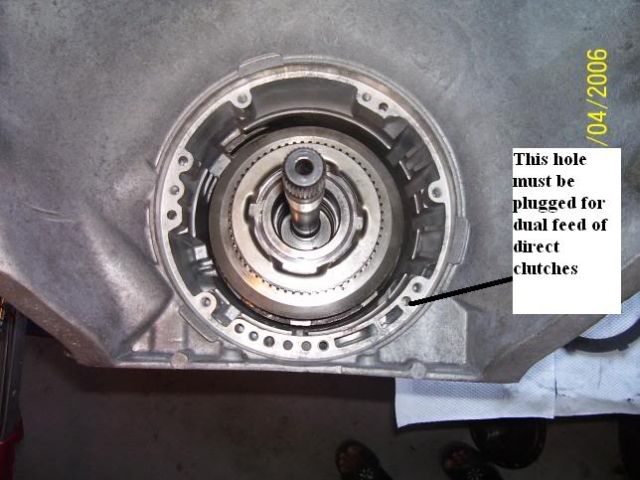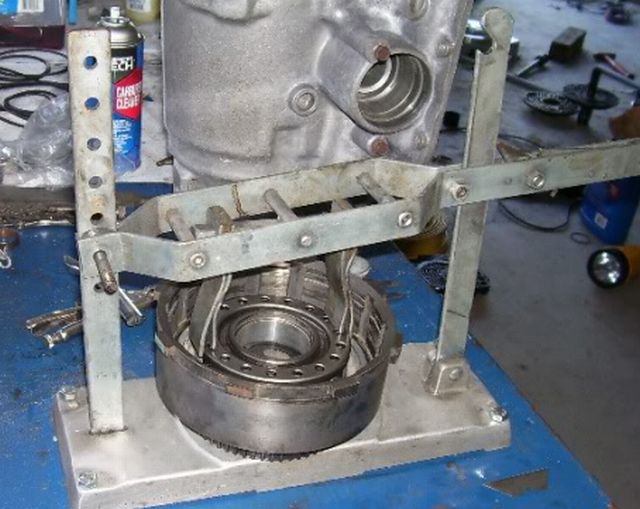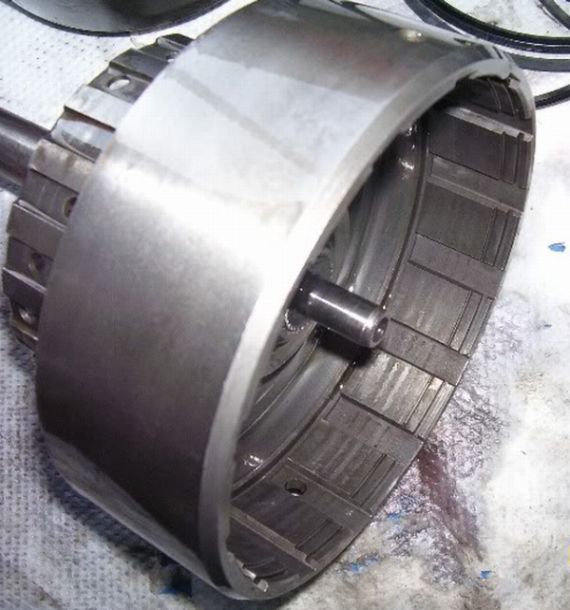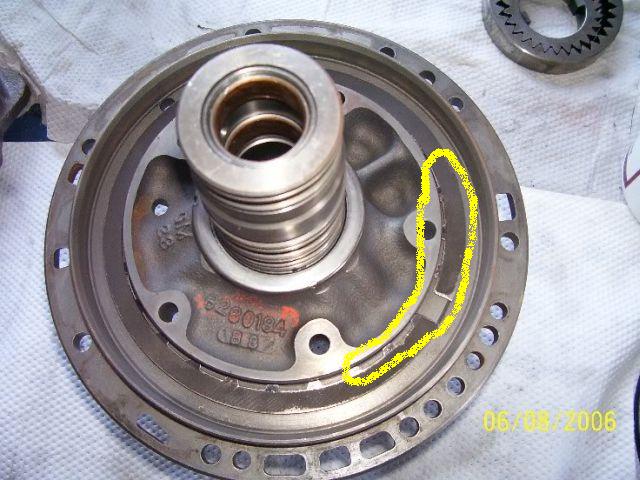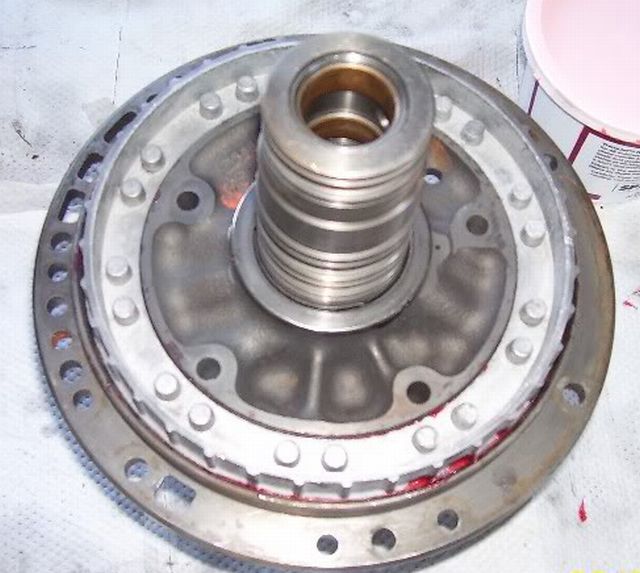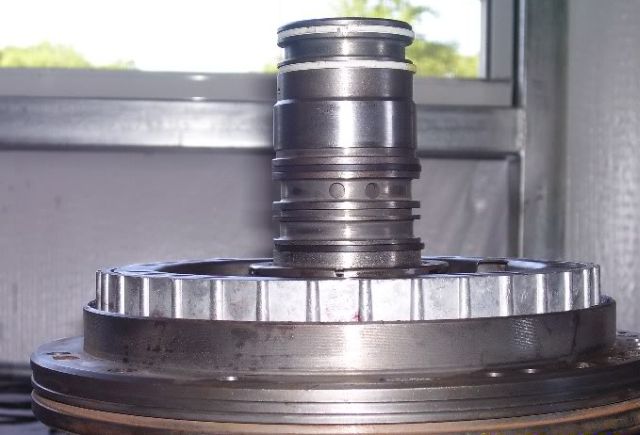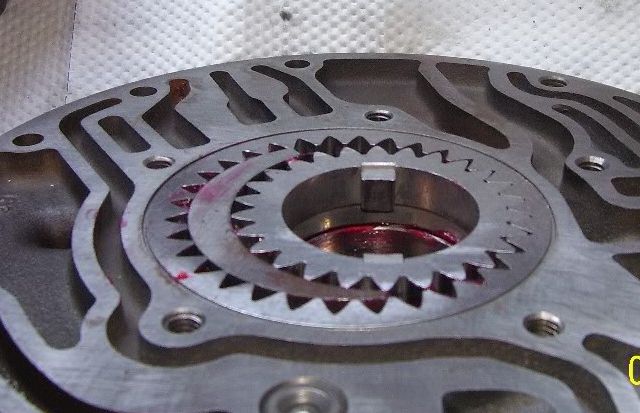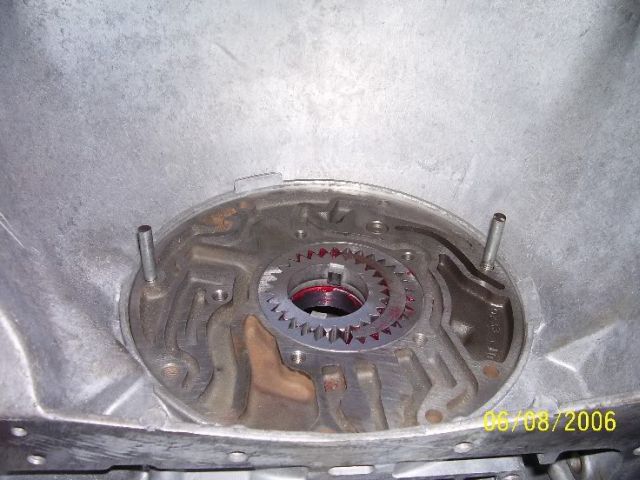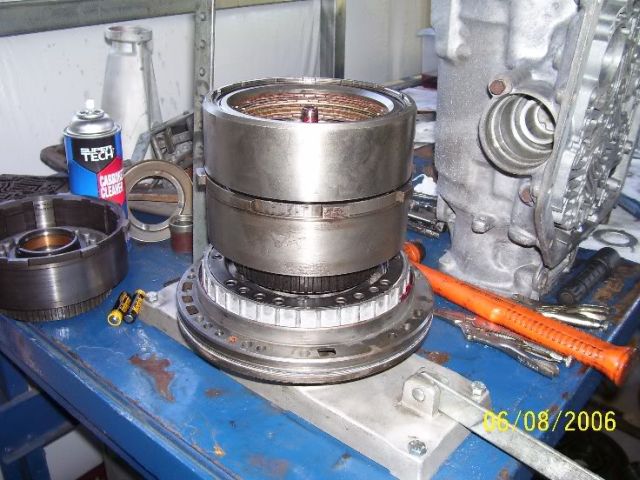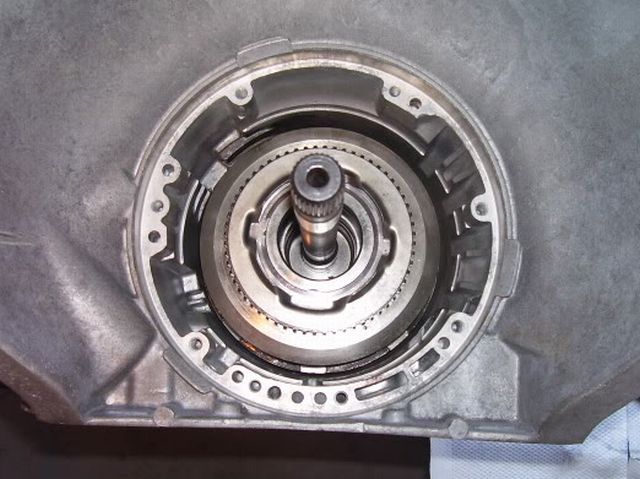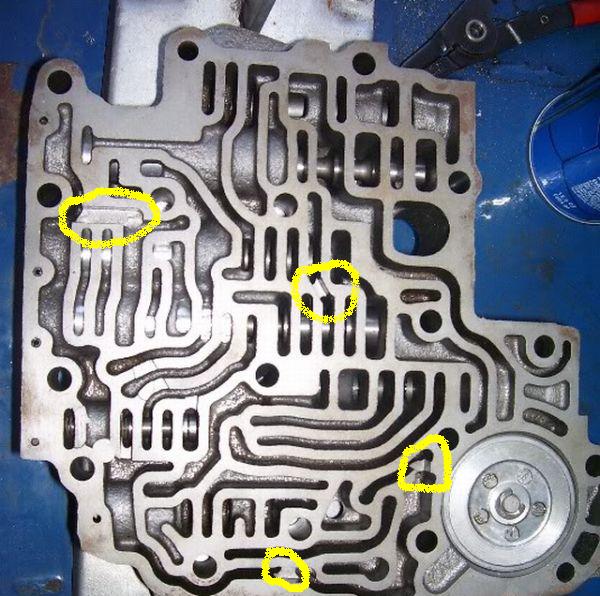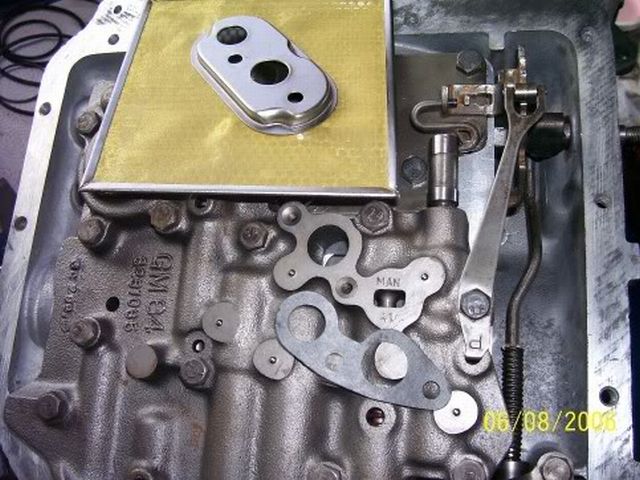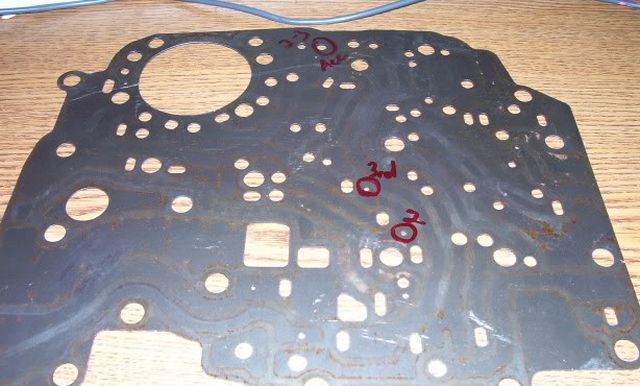T-350 Rebuild tech
From Crankshaft Coalition Wiki
[edit] Rebuilding the T-350
[edit] Basic rebuild information - ---READ THIS!!!!
This WIKI is not intended to be a replacement for an ATSG or Ron Sessions tech manual. First time builders will likely need a tech manual. I would recommend Ron Sessions book "TH350 Handbook" in the HP Book Series. It has good pictures, alot of good info, but has some outdated info. Outstanding value for the money.
This is not a step-by step pictorial, don't assume I have shown where every part goes, there will be some thrust washers not illustrated that were installed and not taken an individual picture to show it because of bandwidth considerations.
That said I hope this helps some understand the T-350 or maybe it'll help when you're elbow deep and have a question.
A T-350 is known to be rough on bushings. Bushings are critical in that they allow the rotating parts to ride true on center, and for the lube to make it to the rear of the trans. Be prepared to replace almost ALL the bushings in a T-350. Might as well order a bushing kit, as well as a thrust washer kit. I would recommend you get at least 2 additional sun gear bushings individually also.
Once the case has been cleaned, all threads checked and or repaired, and the rear case bushing installed you can start assembly.
[edit] Case prep
[edit] 1- 2 Accumulator
Photo shows accumulator cover, spring and piston ( Snap ring not shown)..This is located on right side of trans case
Right side of T-350 case. Pressure ports circled.
- Rear port (yellow) is main line pressure. You will see pressure here in all gears for most valve body configurations. Some race only valve bodys may not have pressure at this port or the others.
- Middle port (red) is 2nd gear pressure
- Front port (blue) is third gear pressure
[edit] Low-reverse piston install
The first item to go in the case will be the low/reverse apply piston. Its function is for oil to force it towards the front or bell housing side of the trans, applying the low/reverse clutches. This allows reverse when applied simultaneously with the direct (high gear) clutches, and allows manual low gear when applied with the forward clutches. Manual low gear creates engine braking on deceleration. The low/reverse clutches do not apply in automatic range 1st gear. The low sprag (low roller clutch actually) causes first gear when only the forward clutches are applied.
In the rare application that does not need reverse or low gear engine braking the low piston and low clutches can be deleted, and the feed holes in the case blocked.
Install new seals on the low piston, these are square cut seals, not lip seals.
Then push it into the rear of the case evenly by hand, aligning it properly so it will seat (there is a "tang"). Look at the park pawl notch to help index it.
Then install the return spring and retainer using the tool pictured.
[edit] Out put shaft install
Next you install the output shaft
Be sure you have the output ring gear to case bearing in the case. Also be sure on dis-assembly you inspected and replaced as necessary the input shaft to output bushing shown here(circled in yellow)
[edit] Rear planetary unit install
Next goes in the output planetary to output ring gear bearing or thrust washer depending on year.
Then the planetary unit. Replace the bushing in this planet.
Now you can install the low/reverse clutches, beginning with a steel, then a friction, alternating, ending with a friction.
Note here, If you have a light duty core with low count low pack, unless it is a transbrake application or will be manually shifted into low for engine braking often, fewer clutches is OK, in some cases, where you are after every lat ounce of ET, using fewer clutches can cause less frictional loss in 2nd and high gear. "Turbulator" steel plates from a 4L60E will also help and are a direct drop-in. I am using Alto red frictions in this unit, however a stock tan clutch (I prefer Borg Warner) is more than adequate for even very high HP cars. A Hi-Energy Borg from a 4L60E is also a good choice.
Once the low clutches are installed, you can install the anti-clunk spring (or case-saver). Both are pictured, the case-saver is solid and spreads the load over a larger area. Hold in place with assembly gel or vaseline and then install the low support. Be sure the low sprag inner race is not brinelled or has any unusual wear.
Once it is pushed into place, install the snap ring, with the ends on each side of the spring or case-saver. Now is the time to air check the low clutches. You do so by applying pressurized air to the passage at the rear pan area of the worm casting in the case.
Next you install the 4 tang thrust washer into the large splines of the low sprag inner race (picture above), and then the sun shell and gear assembly. Before this step, for HD use, you would have wanted to install additional sun gear bushings, 2 on each end, and re-drilled the lube holes. Shown here.
[edit] Install drive shell and front planetary unit
Drop the sun shell/gear in, spinning in the output carrier until it falls in place.
Install the input planet next, pictured below with thrust washer installed.
Now, To prevent excessive end play, a pump thrust washer can be installed on top of the input planet, then the regular thrust washer. Then install the small outside snap ring to hold it all in place. Check the output shaft for proper rotation, there will be some drag, especially in one direction. Check for excessive output end play. If end play is excessive, it can be tightened up by dis-assembling and shimming up the output ring gear bearing from the case.
Now you drop the input ring gear on, spinning into place.
Then install the 3 tang thrust washer onto the top ring gear.
[edit] Direct drum assembly
For racing and heavy towing use, you will want to machine the direct clutch piston down approximately .160" to allow for one extra friction and steel plate for a total of 5 frictions, and 5 steels in the directs. This can be accomplished on a brake lathe.
Stock measurement is .835, I cut them to .700". Ideally you would pre-assemble, and check clearance using a 4 clutch pack, measure the additional thickness of the extra friction and steel, then cut the exact amount needed to leave you the exact clearance you desire. Rule of thumb on most auto trans friction clearances is ~.010" clearance per friction. So a 5 friction direct setup would work great with .050 to .070 clearance. It will work with less, I wouldn't go less than .040", and will work with quite a bit more, but excessive clearance can result in delayed engagement, busted lip seals, and unsatisfactory shift quality.
If the piston is too low, the bottom flat steel plate can drop below the grooves in the drum and bind up the piston. You can leave out center cushion seal if dual feed is used.
The HD applications should also get a heat treated intermediate sprag
race. It is darker colored than a stock piece.
The intermediate sprag race and intermediate sprag (actually roller
clutch) take a brutal amount of force on a 1-2 shift at high rpm. Even
more so with harsher shift calibrations. It is the weakest single part
of a T-350.
This is not to say a T-350 is not tough, they are under-rated and can
reliably handle in the 600HP or lb/ft range based on my experience.
I also like to always use a NEW intermediate roller clutch for HD builds. My theory on a long lived setup is that the springs that force the rollers against the race must be in good condition to helps the rollers grab quicker and more evenly on apply.
The parts go on the direct drum.
Assembled direct drum sprag and race with retainer
The direct drum should use a wider bushing even on stock rebuilds.
Stock is .500 a wider .750 is available in some bushing kits. Most
bushing kits include the wide one.
There is a lot of load on this bushing, and it should ALWAYS be replaced on overhaul.
Also check the inside bore of the drum for wear from the sealing rings. A
small amount of wear can be honed out. Visual shiny spots with no
detectable wear are OK.
Next you will install the direct piston lip seals, and install the piston in the drum.
Take note of the orientation of the seals, the lip will face towards the "oil" side of the piston, not the clutch side.
This is a hi-performance T-350 and I did NOT install a lip seal in the drum that would separate the two halves of the direct piston. This is part of the process of "dual-feeding" the direct clutches. On a stock rebuild you would normally install this lip seal. You can do this on any rebuild but you must also block a passage in the case near the pump to prevent loss of pressure to the reverse circuit.
[edit] Dual Feed direct drum
Dual feeding doubles the area of the piston that has pressurized fluid on it in 3rd gear, more than doubling the capacity of the clutch. It is accomplished by most valve body kits without doing so internally but requires a "transfer" plate and gasket to be added under the support plate in front of the valve body. I prefer internally dual feeding because it leave out the additional gasket and eliminates that one extra possibility for a pressure loss resulting in burnt 3rd gear clutches (Yes it has happened to me). All transbrakes will require dual feed of the direct clutch, as well as many manual valve bodies.
Here is the passage that must be blocked. I usually tap this hole with a 3/8" tap, and cut off the end of a 3/8" bolt. I then slot the head of the bolt so I can use a flat-tip screwdriver.
I don't thread the passage completely to bottom. I want the "plug" to seat on the unthreaded portion.
May also use roller from a direct drum or sprag to drive into the passage, will not be able to remove!
Also of note, if you are using almost any aftermarket kit, these kits use a feed plate between the support plate in front of the valve body and the separator plate. This feed plate dual feeds the directs and plugging this hole is unnecessary. Also most manual valve bodies, trans-brakes, etc will have you omit the direct drum center seal and the sealing ring on the stator but plugging of this hole is also unnecessary due to the design of the separator plate.
Don't assume you need to plug this hole. Only plug this hole if you plan on building a unit yourself.
You can omit the center seal, plug this passage, enlarge the 2nd and 3rd feed holes in the stock separator plate and you will have greatly increased the torque capacity of a stock TH350 as well as gained a firmer shift. Even firmer shifts can be accomplished with check ball removal and modifications to the accumulators. I recommend NOT modifying the 1-2 accumulator. Retain the cushion spring and do not block the circuit. The 2-3 accumulator can be blocked by several methods. Removing the 2-3 accumulator spring and using a spacer (nut, washers, cut down section of tubing) between the piston and the e-clip is the "shade tree' method. You can also block the feed in the valve body to the 2-3 accumulator.
Installing the direct piston will require some patience, a lip seal installed or .010" feeler gauge, and a trick I use is a section of plastic cut from a 3 liter soda bottle to use as an outside installer tool. Set it in the drum, and it will force the lip seal into the drum without using a tool around the entire circumference. You may however need to work the exposed part of the seal into the drum with the feeler gauge or seal tool. Use care using the lip seal tool, I use a push-in technique more than a work around the drum technique. If you slide around the drum, and it catches the seal it will cut it and then you must get a new lip seal and start again. Good lighting, patience, and technique are key here, oh, and a good air check
Once you have the piston seated in the drum you can install the return springs and retainer.
You can buy or make a tool similar to the one pictured or use 2-3 5" or larger c-clamps (much more of a PITA).
Forward drum procedures are almost identical. No center seal to worry
about on a TH350, it typically already has a 5 clutch pack, except light
duty applications. Same 0.700 thickness piston for 5 frictions and
steels. Removing the wave plate will cause harsh forward engagement.
Reduce clearance of the stack to .040.
Forward clutch pack clearances can be tighter than usual, however it must have some clearance. If too tight it can creep in neutral.
Forward drum inspection: Pay attention to this polished stub of the input shaft, it goes into the bushing that is in the end of the out put shaft. It is a high wear area. Be sure it is smooth. Minor scoring can be smoothed down. May consider use of teflon bushing, only a lubrication passaage, no pressure, no lateral loading.
Notice the scraped and split low reverse friction in the intermediate piston cavity. This slightly tightens the intermediate clutch clearance to achieve cleaner 1-2 shift.
Intermediate piston installed
Sealing rings on the pump stator. Notice the missing sealing ring 2nd from bottom. You can remove this ring if dual feeding.
Pump gear install. Note the orientation of the tangs on the inner gear. They are offset. They should face away from the seal. Mis-installation will result in pump failure and converter damage.
Notice the dowel pins threaded into the case, you use these and the case to align the pump halves.
This is an example of how I air check the forward and direct drum. After everything is assembled, I place the drums on the pump (above a hole in the bench) with all sealing rings in place, thrust washers or bearings. Use a rubber tipped air nozzle to apply air to the passages around the pump circumference. As you apply air to the correct passages, you will see and hear the drums apply the clutches. Be sure there are no leaks from the lip seals. There will be some minor leakage at the sealing rings usually. Iron rings air check better than teflon on the bench.
Drums installed in the transmission case. Ready for intermediate pressure plate install. Ensure the lugs of the direct drum are engaged with the sun shell. They should be slightly below the top edge of the suin shell. If you do not get complete engagement, the input shaft will not turn when you install the pump and begin to tighten it.
Coan reverse manual valve body. Notice the machining of passages.
Brass screened filter allows for more flow.
Here's a pic of the feed holes. These regulate the amount of fluid, or how fast, it can apply the clutches. Drilling them bigger allows a faster apply.
However,bigger is not always better.
Remember that as the load increases on the trans, so does the pressure. The increase in pressure will cause the fluid to move faster and shifts to be firmer.
If you drill the holes too big the shifts become too harsh at light throttle openings. This causes undue wear on the internal transmission parts, rear differential and axles, drive line and u-joints.
The ideal situation is a shift that gets progressively harder with greater throttle openings.
I recommend drilling the 2nd feed to .125" and the 3rd feed from .125-.140"
Also note the 2-3 accumulator hole marked in the upper portion. This hole can be blocked but it is easier to block the passage in the VB or the 2-3 accumulator piston as previously mentioned.
This article was rated 20 time(s) with a score of 4.8500 point(s) (until 17:54, 19 November 2011).
There is a total of 0 links pointing to the references (0) in this article. The total size of the sites used as references in this article is 0. 0 links are pointing to this site (until 17:54, 19 November 2011).
This article has been accessed 3581 time(s) (until 17:54, 19 November 2011).
